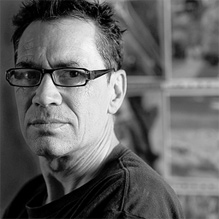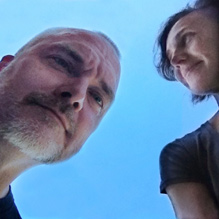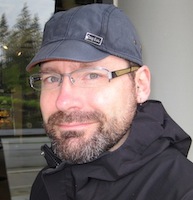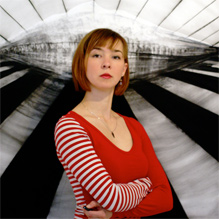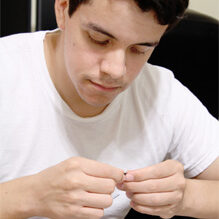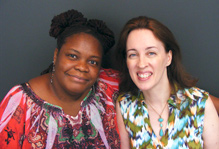Mobile phones, tree and Arduino Collage
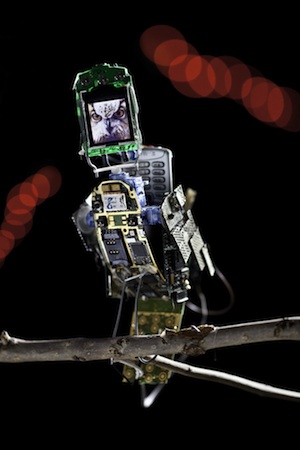
This installation takes familiar, often stressful and annoying devices, and creates an alternate reality that uses disposable unwanted phones and unwanted noises and turns them into something beautiful. Each bird consists of a load of broken phone junk. The working phone communicates via serial to a device that then decides how the bird should move, when it should answer calls (from the public or other birds) and when it should make calls.

Neil Mendoza and Anthony Goh
My name is Neil Mendoza and I’m an interactive artist based in London. I use digital and mechanical technology to bring objects and spaces to life. My work has been displayed at the Science Museum, The V&A, Watermans, PICNIC Festival, The AND Festival, The Nottingham Playhouse, BBC Big Screens and The Museum of London, among others.
Skills Applied
 BASIC ELECTRONICS
BASIC ELECTRONICS
 ARDUINO PROGRAMMING
ARDUINO PROGRAMMING
ARTIST SUGGESTION
The birds are made out of pieces of junk mobile phones that have been brought hack to life. To do this, I used a piece of hardware called an Arduino. It is a tiny computer that allows you to interact with the physical world using electronics. The moving parts of the birds are controlled by small motors called servos. Go to the Instructables website and have a search for Arduino projects, there are plenty of great ideas for projects along with detailed instructions on how to make them a reality.
Stemarts Design Tool
Explore the site to come up with your idea. Pick an artist or topic.
This artist is one of 20 ISEA2012 artists featured in this curriculum. Explore them all to see which you would like to use as a model for your project. It could be a combination of different artists and topics that inspire the work. Print out the STEMArts Design Tool which outlines these steps and use it as a guideline in your process. Visit the Wiki-Resource on each artist page to see tutorials, activity ideas, read articles about the medium that the artists explored and other resources to help you find something that peaks your interest. Click on the Artist Interview button on each page to read a personal interview with each artist. The artist was asked questions to share their creative process, talk about the medium they work with, and to share tips and advice for you as you begin your design process. In this phase, you are looking for inspiration for an project that is meaningful to you. Get a journal and start sketching and writing notes on your process.
Brainstorm and come up with ideas for your art piece.
In this phase, you will need to sketch, doodle, contemplate, or journal, in order to start allowing ideas to formulate. Search the Wiki-Resource under keyword “brainstorming” to explore some techniques and articles. The artists in the Artists Interviews also share their personal brainstorming techniques. Read through all these resources and do some research yourself. Then set aside some daydreaming time and get started. Think big and let all the ideas you have hit the page without editing them. Get in the flow and write or draw in a journal any ideas you come up with that you would like to explore further.
How are you going to turn the idea into a reality? Research.
Brainstorming and researching go hand in hand. You will be going back and forth between the two until you come up with a plan. Once you brainstorm some great ideas for an art piece you will need to research to learn more about the topic or medium. In turn, that leads to more brainstorming. How are you going to turn the idea into a reality? What materials do you need? Can you build it yourself or will you need help? In your journal make a list of any questions or concerns that come to mind. Search the Wiki-Resource under the keyword “research tips” for ideas, and explore on your own to find the answers to your questions. If you need to collaborate on this piece, decide who that will be and make plans to work together.
Start your design plan.
You have everything you need now to start creating. Refer to your journal to review your process up until now. Review the STEMArts Design Tool. Research online if you still have a question about anything. Ask your teacher for help. Now, it´s time to make a materials list and sketch out your plan of action. Or perhaps you prefer to dig in and start building something? There are many ways to approach it and every artists has their own style. Each artist shared their own design approach in the interviews. Look back over them and see which approach suits your style. Start creating!
See how it works, test and re-test until you get what you want.
The design process always involves testing out your ideas in the real world, and building prototypes to see if it works. You also may find that once you start building it, it is not what you had in mind. This is part of the process. It helps to document everything you do in your journal. This is the hardest stage because it is easy to get discouraged. Read about what the ISEA2012 artists say about this phase. Ask for help when you need it. If you get stuck, go back to the brainstorming phase for new ideas. Get feedback from your teacher, your friends, and experts. We created a Troubleshooting Guide to help you evaluate and critique your work in case you are stuck on your design.
Practice presenting in order to get feedback for your finished piece.
You have probably explored options for presenting your work but this is the time to work out the details. Your venue will often determine the presentation format. Now is a good time to present your work to friends and peers to get some feedback. Our Feedback Survey poses questions that will help you critique your own work, and provides tips on receiving constructive feedback from others. It will also help to look back on your design process to see if you are where you want to be with your art piece.
Bringing it all together. Time to share it.
Sharing your work can be scary and thrilling at the same time. Hear what artists have to say about the importance of sharing their work with the public. Do you want to share it in your community? Is there a venue interested in what you have created? Will you use Vimeo, YouTube, a blog? Search under keyword “Share tools” in the Wiki-Resource for some links and ideas.
STEMarts Wiki
Search this open source wiki for links to learn more about the type of art, medium and STEM topics explored in the Escape project. We suggest starting with the Instructables link using servos and includes 2 simple projects, which will help you explore some of technical aspects of the Escape project.
You will also find links to articles, images, video, tutorials and more to provide a starting point for your research in creating an art piece or project inspired by the Escape project. If you have find anything interesting on your own please consider sharing it in this open forum.
Remember the resource is an open forum sharing links and ideas that others have found – always check your sources and give credit where credit is due. The open source movement generously shares its knowledge and relies on users and sharers feedback – so if there’s something really good or doesn’t work let others know.
Adruino Algorithims Art Art techniques Art Theory Audio Waves Collaboration Collaborative art practice Collage Communication Computer Language E-Waste EcoArt Tech Electromagnetic fields Electromagnetic Spectrum Electromagnetic waves Electronica feedback systems Glitch Music Handmade Electronics Interactive Art Life Systems Mobile / cell phone technology Mobile Phone Art Obsolescence Programming Radio Servo Mechanisms Servo Motors Smart Phones Sonic Art Upcycling VIEW ALL Waves
NEXT GENERATION SCIENCE STANDARDS
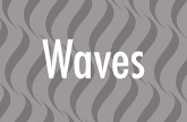
Core Idea PS4: Waves and Their Applications in Technologies for Information Transfer
PS4.A: Wave Properties
PS4.B: Electromagnetic Radiation
PS4.C: Information Technologies and Instrumentation.

